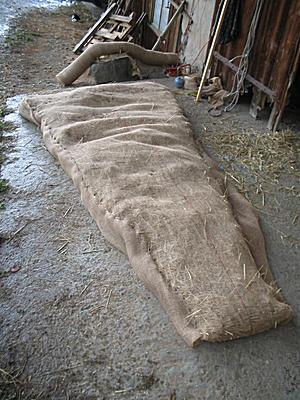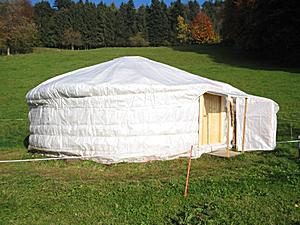
|
Page << Prev | 1 | 2 | 3 | 4 | 5 | 6 | 7 | 8 | 9 | 10 | 11 | 12 | 13 | 14 | 15 | 16 | 17 | 18 | 19 | 20 | 21 | Next >> Yurt / Ger Diarywritten by Rene K. Mueller, Copyright (c) 2005, 2006, 2007, 2008, 2009, last updated Sat, January 3, 2015 27. 11. 2007: Winter - No Snow Anymore
Föhn kept the temperatures high (over 10°C at some days) even after sunset. Now we just have typical November weather, cold winds from north / north east.
20. 11. 2007: Warmer Temperatures, Very Localized Climate, Wood UsageThe last days I usally fired once a day, in the morning to reach 22°C inside, lasting til sunset. After sunset the temperature fell rather fast as outside it dropped below 0°C and finally -10°C outside, inside the yurt down to 15°C at 22:00 and next morning down to 2°C.
Yesterday and today "föhn" (see Wikipedia: Föhn Until now I used 2 boxes of wood, hard wood predominatly beech which burns slower than fir, 17 boxes make up 1 ster (1m3 chopped wood), which is apprx. ~0.75 m3 compact wood. If I fire the stove once a day I use 1 box a week, 1/17 of ster the week. Five more weeks til end of year, plus apprx. 10 weeks til first mid of March when usually a warmer period comes, which makes estimated 17 weeks or 17/17 or 1 ster for the fall/winter season, but I expect, if this winter is colder than the last warm winter (one of the warmest recorded here), that I will use for sure more than 1 ster of wood, at max 2 ster I would say. Let's see. 18. 11. 2007: Chilly Temperatures, Fixing Pipe Insulation
Yesterday I also fixed the thermal insulation of the stove pipe, where the pipe goes between wall and roof outside - the junction has been a bit under tension as I used it to attached to fixate some of the cords over the roof. The junction, two pipes moved into each other, moved apart and leaked a bit smoke inside the yurt - which I had to fix, and finally I had to dismantle the insulation partially again in order to push two pipe parts into each other again. My pipe insulation looks like this: I use glasfoam, apprx. 2-3cm thick, 60cm wide, 1m long, and rolled it over the stove pipe 60cm wide, 2-3 times around - then I used stiff wire to fixate it, and then aluminium foil, which I taped with clear tape so the foil is not teared away when I move it between the lattice wall/roof junction.
This is also a number one might think about when constructing a yurt, the width w (as mentioned in yurt calculator) of the junction distance of the lattice wall, keep it larger than your stove pipe plus thermal insulation, this way if you choose the pipe to leave the yurt by the wall/roof junction, you don't need to cut any part of the lattice wall.
16. 11. 2007: Deep Wintertime
After 1.5 hours firing the stove I reach 15°C inside - and the sun reaches finally the yurt as well around 10:15.
15. 11. 2007: More Snow
Later in the afternoon I cleared part of the roof which extends over the attached room, there two cords fasten the extension yet prevented the snow to slide.
14. 11. 2007: First Lasting Snow of the Winter Season
Maybe bands may pose less resistance to sliding snow, than cords - I'm not sure. As mentioned before, one of the main advantage of PE as rain cover is that snow just slides down, one has little to worry of snow piling up on the roof and risk breaking the entire yurt once 50cm or more heavy snow remains on the roof (e.g. as with cotton/polyester rain cover).
13. 11. 2007: Putting Up Two More Roof SegmentsI just moved the two segments on the roof, balancing the overall weight of the thermal roof insulation thereby - with the sacrifice of less translucent bubblewrap section on the roof. On the wall I have apprx. 1/4 of the circumference with 4 layers of single layered bubblewrap, probably the last season as it disintegrate slowly due UV exposure.
It's now significantly darker as seen on the last picture, but the crownwheel already adjusted slightly, there is a slight remaining adjustment which will occur within the next days or the next storm, as I can't simply shake the roof that hard to bring it in balance. In such cases you realized how "alive" a yurt is, how the lack of hard fixations make it almost a liquid setup, for the lack of a better word. 12. 11. 2007: 3 Days Storm, Rain and Snow Fall
I decided to make at least 2 roof segments of thermal insulation, and narrow the bubblewrap segment further, and balance the weight on the roof more even. As the storm titled the crownwheel even more, it's just 5cm maybe at most, but I like to maintain a horizontal crownwheel to have all vertical forces of the roof poles distribute the force at the same angle to the crownwheel.
For now I didn't put up the two roof segments as still hail/snow is on the roof which fell this afternoon, so I wait til the rain cover is clear and dry to partially lift it up and get access to pull the segments on the roof.
The roof segment have the same size as when I made them last fall, 50cm (top) - 180cm (bottom) wide, and 340-345cm long (empty) and filled finally apprx. 30cm (top) - 160cm (bottom) wide and 320cm long when filled. I used 1 1/2 bales of straw for the two segments. 9. 11. 2007: First Fall Storm
The crown-wheel tilted further due the storm, unfortunately, due the one quarter of the roof where there is no straw-based insulation, but light bubblewrap layers. Tonight first lasting snow falls, at 0°C - not really covering up the entire ground. 7. 11. 2007: First Snow BrieflyI was away for a few days visiting friends, and temperatures from 0° to 8°C, with N/NW winds, and some brief snowfall (750m above sea level) which didn't last, only a few spots the snow remained. And I had friends coming by and stay overnight, so I started to use the stove now - heating up to 25°C, with little wood fireing for 1.5 hours last evening. The new roof extension over the door works well, it might not really storm proof as I just nailed the two jambs on the first step on front of the door - but the front door didn't catch any direct rain water. I also catched the two mice which walked or eat themselves from my straw insulation. Since the weather is cooler I also have more space to make again soy yoghurt and keep it stored for a couple of days. I refrained to make soy yoghurt during the hotter months due lack of sufficient cool storage space.
1. 11. 2007: Sunny Day Again, Passive Heating from the Sun
Below a few photos of my winter setup 2007/2008 which I likely won't change through the winter, except maybe tighten some of the cords of the attached room once snow is falling. Will be interesting to see if the attached room behaves with sliding snow, I guess some will be withhold at the junction of roof cover and attached room roof cover.
I also noticed two mice which began to climb through the straw insulation, I will lay out a mouse trap again to capture them. As I wrote earlier, I wouldn't mind mice if their droppings and urin would be outside, but inside the insulation I don't want it.
Yesterday we had covered sky with a bit of rain, the temperature was 10°C in the morning climbing slowly to 17.2°C max in the late afternoon, I didn't fire the stove but weared more cloths.
29. 10. 2007: Sunny DayToday we had a sunny day, direct sunshine reaching the yurt - now with thermal insulation and south-west quarter of wall and roof with multiple bubblewrap layers translucent, it warmed up the yurt from 10°C to 20.5°C - at 19:30 still 18.4°C (apprx. 2 hours after sunset), outside 5°C with a bit cold draft.Page << Prev | 1 | 2 | 3 | 4 | 5 | 6 | 7 | 8 | 9 | 10 | 11 | 12 | 13 | 14 | 15 | 16 | 17 | 18 | 19 | 20 | 21 | Next >> Content:
|
| Home | · | About | · |  Tipi | · |  Yurt | · |  Dome | · | Features | · | Gallery |

Creative Commons (CC) BY-SA-NC 2005-2017, developed, designed and written by René K. Müller
Graphics & illustrations made with Inkscape, Tgif, Gimp, PovRay, GD.pm
Web-Site powered by FreeBSD & Debian/Linux - 100% Open Source


































